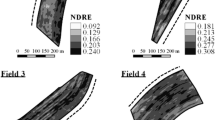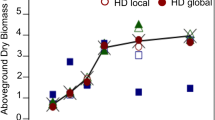Abstract
Nitrogen management has been intensively studied on several crops and recently associated with variable rate on-the-go application based on crop sensors. Such studies are scarce for sugarcane and as a biofuel crop the energy input matters, seeking high positive energy balance production and low carbon emission on the whole production system. This article presents the procedure and shows the first results obtained using a nitrogen and biomass sensor (N-Sensor™ ALS, Yara International ASA) to indicate the nitrogen application demands of commercial sugarcane fields. Eight commercial fields from one sugar mill in the state of São Paulo, Brazil, varying from 15 to 25 ha in size, were monitored. Conditions varied from sandy to heavy soils and the previous harvesting occurred in May and October 2009, including first, second, and third ratoon stages. Each field was scanned with the sensor three times during the season (at 0.2, 0.4, and 0.6 m stem height), followed by tissue sampling for biomass and nitrogen uptake at ten spots inside the area, guided by the different values shown by the sensor. The results showed a high correlation between sensor values and sugarcane biomass and nitrogen uptake, thereby supporting the potential use of this technology to develop algorithms to manage variable rate application of nitrogen for sugarcane.









Similar content being viewed by others
References
ANFAVEA (2010). Associação Nacional dos Fabricantes de Veículos Automotores—Brasil. http://www.anfavea.com.br/tabelas.html. Accessed 16 September 2010.
BEN (2010). Balanço Energético Nacional—Brasil. https://www.ben.epe.gov.br/downloads/Relatorio_Final_BEN_2010.pdf. Accessed 16 September 2010.
Boddey, R. M., Urquiaga, S., Alves, B. J. R., & Reis, V. (2003). Endophytic nitrogen fixation in sugarcane: present knowledge and future applications. Plant and Soil, 252, 139–149.
Bredemeier, C., & Schmidhalter, U. (2005). Laser-induced chlorophyll fluorescence sensing to determine biomass and nitrogen uptake of winter wheat under controlled environment and field conditions. In J. V. Stafford (Ed.), Precision agriculture’05. Proceedings of the 5th European conference on precision agriculture (pp. 273–280). Wageningen, The Netherlands, Uppsala, Sweden: Academic Publishers.
FAO (2010). Food and Agriculture Organization, Faostat. http://faostat.fao.org/. Accessed 16 September 2010.
Franco, H. C. J., Trivelin, P. C. O., Faroni, C. E., Vitti, A. C., & Otto, R. (2010). Stalk yield and technological attributes of planted cane as related to nitrogen fertilization (Produção de colmos e atributos tecnológicos da cana planta relacionados com a adubação nitrogenada). Scientia Agricola, 67, 579–590.
Heege, H. J., Reusch, S., & Thiessen, E. (2008). Prospects and results for optical systems for site-specific on-the-go control of nitrogen-top-dressing in Germany. Precision Agriculture, 9, 115–131. doi:10.1007/s11119-008-9055-3.
Jasper, J., Reusch, S., & Link, A. (2009). Active sensing of the N status of wheat using optimized wavelength combination–impact of seed rate, variety and growth stage. In E. J. Van Henten, D. Goense, & C. Lokhorst (Eds.), Precision agriculture’09 Proceedings of the 7th European conference on precision agriculture (pp. 23–30). Wageningen, The Netherlands: Academic Publishers.
Link, A., Jasper, J., & Reusch, S. (2005). Suitability of different crop parameters for the determination of site-specific nitrogen fertilizer demand. In J. V. Stafford (Ed.), Precision agriculture′05. Proceedings of the 5th European conference on precision agriculture (pp. 297–302). Wageningen, The Netherlands. Uppsala, Sweden: Academic Publishers.
Mutanga, O., & Skidmore, A. K. (2004). Narrow band vegetation indices overcome the saturation problem in biomass estimation. International Journal of Remote Sensing, 25, 3999–4014. doi:10.1080/01431160310001654923.
Ometto, R. A., Hauschild, M. Z., & Roma, W. N. L. (2009). Lifecycle assessment of fuel ethanol from sugarcane in Brazil. International Journal of Life Cycle Assessment, 14, 236–247. doi:10.1007/s11367-009-0065-9.
Prado, R. M., & Pancelli, M. A. (2008). Sugarcane ratoon response to nitrogen application in a no burn harvesting system. (Resposta de soqueiras de cana-de-açúcar à aplicação de nitrogénio em sistema de colheita sem queima). Bragantia, 67, 951–959.
Reusch, S. (2005). Optimum waveband selection for determining the nitrogen uptake in winter wheat by active remote sensing. In J. V. Stafford (Ed.), Proceedings of the 5th European conference on precision agriculture (pp. 261–266). Wageningen, The Netherlands: Academic Publishers.
SAS. (2009). SAS Online Doc R 9.2. North Carolina: Cary.
Silva, C. B., de Moraes, M. A. F. D., & Molin, J. P. (2011). Adoption and use of precision agriculture technologies in the sugarcane industry of São Paulo state, Brazil. Precision Agriculture, 12, 67–81. doi:10.1007/s11119-009-9155-8.
Singh, I., Srivastava, A. K., Chandna, P., & Gupta, R. K. (2006). Crop sensors for efficient nitrogen management in sugarcane: Potential and constraints. Sugar Technology, 8, 299–302. doi:10.1007/bf02943572.
Solie, J. B., Raun, W. R., & Stone, M. L. (1999). Submeter spatial variability of selected soil and bermudagrass production variables. Soil Science Society of America Journal, 63, 1724–1733.
Spiertz, J. H. J. (2010). Nitrogen, sustainable agriculture and food security. A review. Agronomy for Sustainable Development, 30, 43–55. doi:10.1051/agro:2008064.
UNICA (2010). União da Indústria de cana-de-açúcar—Brasil. Union of the Brazilian sugarcane industry. http://www.unica.com.br/dadosCotacao/estatistica/. Accessed 16 September 2010.
Vitti, A. C., Trivelin, P. C. O., Gava, G. J. C., Penatti, C. P., Bologna, I. R., Faroni, C. E., et al. (2007). Sugarcane yield related to the residual nitrogen from fertilization and the root system (Produtividade da cana-de-açúcar relacionada ao nitrogênio residual da adubação e do sistema radicular). Pesquisa Agropecuaria Brasileira, 42, 249–256.
Acknowledgments
All this work would not be possible without the collaboration of São Martinho’s Mill team, the support of Máquinas Agrícolas Jacto SA and the Research Fellowship to the first author from the Brazilian Government (CNPq—National Council of Scientific and Technological Development).
Author information
Authors and Affiliations
Corresponding author
Rights and permissions
About this article
Cite this article
Portz, G., Molin, J.P. & Jasper, J. Active crop sensor to detect variability of nitrogen supply and biomass on sugarcane fields. Precision Agric 13, 33–44 (2012). https://doi.org/10.1007/s11119-011-9243-4
Published:
Issue Date:
DOI: https://doi.org/10.1007/s11119-011-9243-4




